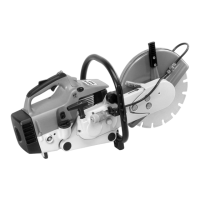Mechanical design and function
The housing (1) and piston (2) are the most
important elements of the decompression valve.
The piston can move axially in the housing.
A cone is fitted at the bottom end.
Three spring-loaded balls (3) offset at angles of
120 degrees hold the piston in its upper and lower
limit position. The complete decompression valve
is screwed into the cylinder.
Before starting, the piston (2) is forced into the
lower limit position and the cone lifts off the
housing (1). The decompression valve is now
open.
The pressure in the cylinder does not rise above
the closing pressure of the decompression valve
until a combustible fuel/air mix has ignited. The
piston (2) is then forced upwards and the hole (1)
is sealed by the cone.
337TI002
1
2
3
337TI003
1
2
3
The V-belt tensioner has already proved its worth
in the STIHL TS 460 and has improved the operating
convenience. All that is required in
order to tension the V-belt is to turn the tensioning
nut to the tensioning position. When that has been
done, the V-belt is correctly tensioned automatically
by the force of a spring. Retensioning the belt is
even simpler and quicker: only three hex bolts
need be unscrewed and then retightened on the
V-belt guard. There is no need to adjust the
tensioning nut. The constant spring force prevents
the V-belt from being tensioned excessively and
thus protects it against premature wear.
338TI002 K
Technical Information 37.95 - Page 4

